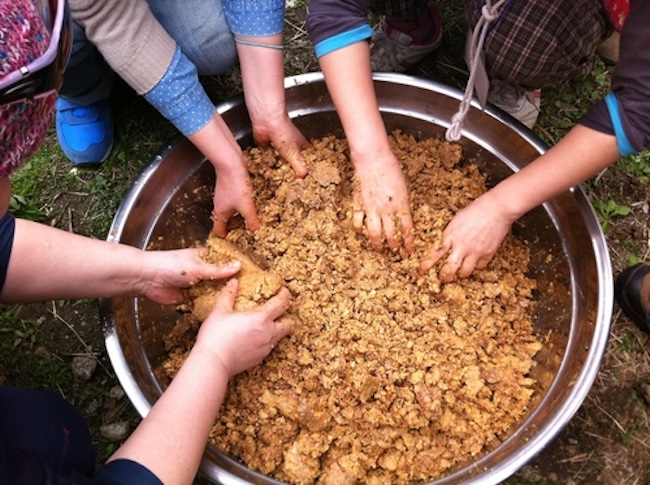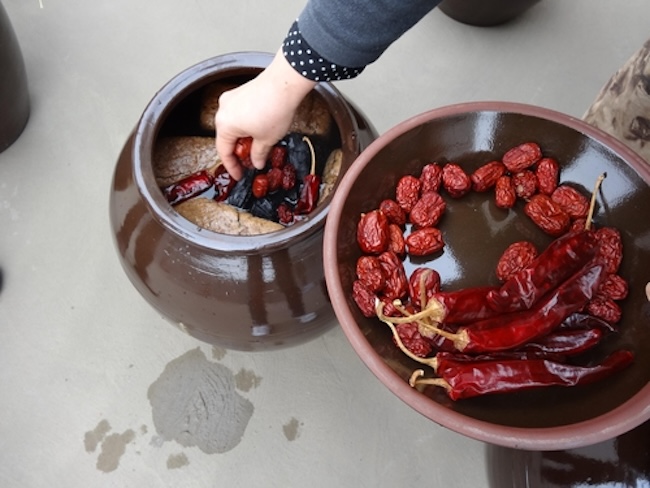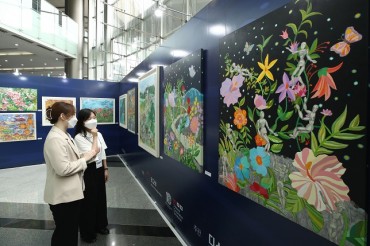
Employees at a farm in Anseong, Gyeonggi Province, clean dust off jars that accumulated during the winter at a traditional Korean outdoor storage area for “doenjang,” a fermented soybean paste, on a warm spring day on March 27, 2024. (Image courtesy of Yonhap)
SEOUL, Nov. 5 (Korea Bizwire) — Korea’s tradition of making fermented sauces using soybeans is likely to be added to UNESCO’s list of intangible cultural heritage.
UNESCO said Tuesday its deliberative body has categorized “knowledge, beliefs, and practices related to jang-making in the Republic of Korea” as recommended for inscription.
The Republic of Korea is South Korea’s official name.
“Jang” is a traditional Korean fermented soybean-based condiment foundational to many Korean dishes. It includes several varieties, such as “doenjang” (soybean paste), “ganjang” (soy sauce) and “gochujang” (red pepper paste).

People make “doenjang,” a traditional Korean soybean paste, in this undated photo provided by the National Heritage Service. (Image courtesy of Yonhap)
As one of Korea’s long-standing food traditions passed down through generations, jang-making encompasses not only the sauce itself but also the entire process, from ingredient preparation to the final product.
Since the Three Kingdoms period (57 B.C.-A.D. 668), Koreans are known to have enjoyed making and consuming jang. During the Joseon Dynasty (1391-1910), jang was so highly valued that royal storerooms were established specifically to store it, with court ladies in charge of its management.
Even among cultures that consume fermented soybeans, Korean jang is noted for its uniqueness. The process includes soybean cultivation, “meju” (fermented soybean blocks) production, jang-making, dividing the jang, and steps for aging and fermentation, all of which differ from methods used in China and Japan.
Especially distinctive to Korea is the technique of creating both doenjang and ganjang from the same meju and adding new jang to leftover soy sauce from the previous year, which is considered a uniquely Korean cultural practice. Recognizing its cultural value, jang-making was designated a national intangible heritage in 2018.

This undated image provided by the National Heritage Service shows the process of putting red jujubes and peppers into an earthenware jar filled with fermented soybean paste. (Image courtesy of Yonhap)
The evaluation committee noted Korean jang culture forms the core of Korean culinary tradition, alongside rice and kimchi, and highlighted that each household has its own unique taste and method, reflecting the family’s history and tradition.
A final decision is expected between Dec. 2-7, when the Intergovernmental Committee for the Safeguarding of Intangible Cultural Heritage meets in Asuncion, Paraguay.
Applications for the list fall into three categories: “inscribe,” “refer” and “not to inscribe.” Items recommended for inscription are typically adopted by the committee as part of humanity’s intangible cultural heritage.
The jang-making culture, if inscribed, would be South Korea’s 23rd entry on the UNESCO list, which already includes ancestral royal rites, a percussion instrument performance known as “pansori” and the 5,000-year-old dance “ganggangsullae.”
There were 58 applications for this year, of which 57 were recommended for inscription and one was advised to “supplement more information.”
Also among the 57 is the North Korean application called “Custom of Korean costume: traditional knowledge, craft skills and social practices in the Democratic People’s Republic of Korea.” The Democratic People’s Republic of Korea is the official name of North Korea.
The Korean clothing custom, if included, will be the North’s fifth entry on the intangible heritage list.
(Yonhap)






